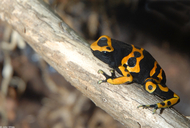|
Dendrobates leucomelas Steindachner, 1864
Yellow-headed Poison Frog, Yellow-banded Dart Frog, Bumblebee Poison Dart Frog | family: Dendrobatidae subfamily: Dendrobatinae genus: Dendrobates |
 © 2008 John White (1 of 29) |
|
|
|
Description Unique glandular adhesive pads are present on the toes and fingertips, helping D. leucomelas to climb and stay in stationary positions. D. leucomelas also lacks webbing on its feet. Although adult D. leucomelas have been illustrated extensively, no illustrations of this species' tadpoles exist (USGS 2002). Distribution and Habitat Country distribution from AmphibiaWeb's database: Brazil, Colombia, Guyana, Venezuela
D. leucomelas prefers moist or wet, forested, lowland regions and temperatures often reaching 30° C or warmer (Silverstone 1975; Honolulu Zoo 2002). They are usually found between 50 and 800 meters above sea level in leaf litter, fallen trees, forest floors, stones and occasionally trees (Honolulu Zoo 2002; Walls 1994). They are native to South America but in 1994 one individual was collected on Honolulu, Oahu, Hawaii, possibly due to a pet release (USGS 2002). Life History, Abundance, Activity, and Special Behaviors D. leucomelas is toxic in its natural environment and derives its skin toxins from the ants in its diet (Caldwell 1996). It is the only poison frog known to estivate during the dry season (Walls 1994). Males will chirp, buzz, trill, and hum to get females attention while also showing off their brightly colored bodies for an hour or two after sunrise and before sunset (Honolulu Zoo 2002; Walls 1994). Once a female chooses a male she will follow him to his area and stroke his back and snout. Sometimes both the male and female will slowly circle one another and stamp their feet (Walls 1994). D. leucomelas females compete for males, and the terrestrial eggs are guarded by the male parent in a moist, sheltered area (USGS 2002). The male rotates the eggs every so often so that they receive enough oxygen. Unlike most historionicus-group dendrobatids, the D. leucomelas tadpoles do not rely on eggs for nutrition but they will accept almost anything for food (Walls 1994). Once they hatch, the tadpoles are carried on the father's back to small pools of water where they continue to develop (USGS 2002; Richard Stockton College 2002). Metamorphosis takes 70 to 90 days; froglets resemble miniature adults but have duller colored bands. In captivity the froglets must eat regularly (fruit flies, pinhead crickets, and other small insects); going without food for 48 hours can lead to death. Some people have observed that they have a "sweet tooth" for small caterpillars (Walls 1994). Trends and Threats Relation to Humans Some compounds of their skin have pharmacological properties, and have proved to be valuable in biomedical research (Honolulu Zoo 2002). Possible reasons for amphibian decline General habitat alteration and loss Comments This species was featured as News of the Week June 12, 2022: Color and pattern phenotypes in amphibians are often ecologically important. A well known example is the role of bright warning colors advertising toxicity in poison frogs of the genus Dendrobates. In a new study, Yuan et al. (2022) highlight an underappreciated axis of color pattern diversity in three species of Dendrobates (D. auratus, leucomelas, tinctorius): age-related, within individual variation. Using a long-term longitudinal study of frogs at the National Aquarium, they show that the relative area of bright color decreases and melanization increases with age in Dendrobates poison frogs. Their results set the stage for future studies to investigate the mechanism by which melanization increases with age and the ecological consequences of color pattern change in these conspicuous frogs. (Written by Michael Yuan)
References
American Museum of Natural History, Department of Herpetology (2002). Amphibian Species of the World Database. http://research.amnh.org/cgi-bin/herpetology/amphibia. Barrio, C. L. and Fuentes, O. (1998). ''Distribución de Dendrobates leucomelas (Anura: Dendrobatidae) en Venezuela.'' Acta Biologica Venezuelica, 18(3), 35-41. Barrio, C.L. and Fuentes, O. (1999). ''Sinopsis de la familia Dendrobatidae (Amphibia: Anura) de Venezuela.'' Acta Biologica Venezuelica, 19(3), 1-10. CITES (2002). Cites Website. http://www.cites.org. Caldwell, J. P. (1996). ''The evolution of myrmecophagy and its correlates in poison frogs (Family Dendrobatidae).'' Journal of Zoology (London), 240(1), 75-101. Frank, N. and Ramus, E. (1995). A Complete Guide to Scientific and Common Names of Reptiles and Amphibians of the World. NG Publishing Inc., Pottsville, Pennsylvania. Honolulu Zoo (2002). ''Yellow-banded Dart Frog'' Archived at: https://web.archive.org/web/20020605132325/http://www.honoluluzoo.org/yellow-banded_dart_frog.htm McKeown, S. (1996). A Field Guide to Reptiles and Amphibians in the Hawaiian Islands. Diamond Head Publishing, Los Osos, California. Myers, C. W. and Daly, J. W. (1976). ''Preliminary evaluation of skin toxins and vocalisations in taxonomic and evolutionary studies of poison-dart frogs (Dendrobatidae).'' Bulletin of the American Museum of Natural History, 157(3), 173-262. Richard Stockton College of New Jersey Biology (2002). Information on the Breeding Cycle of Poison Dart Frogs. http://www2.stockton.edu/academics/undergraduate/natural_and_math_science/labs/biology/html/poison_frogs/info_breeding.html Silverstone, P. A. (1975). ''A revision of the poison-arrow frogs of the genus Dendrobates Wagler.'' Natural History Museum of Los Angeles County, Scientific Bulletin, 21, 1-55. USGS (2002). ''USGS NonIndigenous Aquatic Species .'' ''http://nas.er.usgs.gov.'' Walls, J. G. (1994). Jewels of the Rainforest: Poison Frogs of the Family Dendrobatidae. J.F.H. Publications, Neptune City, New Jersey. Originally submitted by: Phoebe Lehmann (first posted 2003-01-11) Description by: Michelle S. Koo (updated 2021-05-22)
Distribution by: Michelle S. Koo (updated 2021-05-22)
Life history by: Michelle S. Koo (updated 2021-05-22)
Trends and threats by: Michelle S. Koo (updated 2021-05-22)
Relation to humans by: Michelle S. Koo (updated 2021-05-22)
Comments by: Michelle S. Koo (updated 2021-05-22)
Edited by: Meredith Mahoney and Phoebe Lehmann, Michelle S. Koo (2022-06-12) Species Account Citation: AmphibiaWeb 2022 Dendrobates leucomelas: Yellow-headed Poison Frog <https://amphibiaweb.org/species/1638> University of California, Berkeley, CA, USA. Accessed Nov 22, 2024.
Feedback or comments about this page.
Citation: AmphibiaWeb. 2024. <https://amphibiaweb.org> University of California, Berkeley, CA, USA. Accessed 22 Nov 2024. AmphibiaWeb's policy on data use. |



 Map of Life
Map of Life